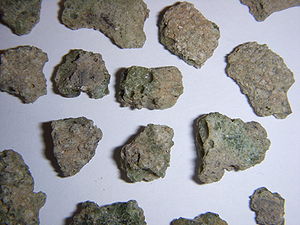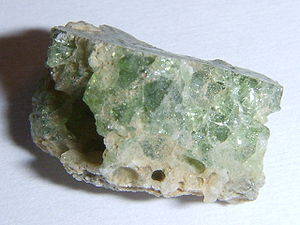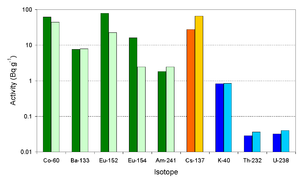
Trinitite
Encyclopedia



Glass
Glass is an amorphous solid material. Glasses are typically brittle and optically transparent.The most familiar type of glass, used for centuries in windows and drinking vessels, is soda-lime glass, composed of about 75% silica plus Na2O, CaO, and several minor additives...
y residue left on the desert floor after the plutonium
Plutonium
Plutonium is a transuranic radioactive chemical element with the chemical symbol Pu and atomic number 94. It is an actinide metal of silvery-gray appearance that tarnishes when exposed to air, forming a dull coating when oxidized. The element normally exhibits six allotropes and four oxidation...
-based Trinity
Trinity test
Trinity was the code name of the first test of a nuclear weapon. This test was conducted by the United States Army on July 16, 1945, in the Jornada del Muerto desert about 35 miles southeast of Socorro, New Mexico, at the new White Sands Proving Ground, which incorporated the Alamogordo Bombing...
nuclear bomb test
Nuclear testing
Nuclear weapons tests are experiments carried out to determine the effectiveness, yield and explosive capability of nuclear weapons. Throughout the twentieth century, most nations that have developed nuclear weapons have tested them...
on July 16, 1945, near Alamogordo, New Mexico
New Mexico
New Mexico is a state located in the southwest and western regions of the United States. New Mexico is also usually considered one of the Mountain States. With a population density of 16 per square mile, New Mexico is the sixth-most sparsely inhabited U.S...
. The glass is primarily composed of arkosic sand composed of quartz
Quartz
Quartz is the second-most-abundant mineral in the Earth's continental crust, after feldspar. It is made up of a continuous framework of SiO4 silicon–oxygen tetrahedra, with each oxygen being shared between two tetrahedra, giving an overall formula SiO2. There are many different varieties of quartz,...
grains and feldspar
Feldspar
Feldspars are a group of rock-forming tectosilicate minerals which make up as much as 60% of the Earth's crust....
(both microcline
Microcline
Microcline is an important igneous rock-forming tectosilicate mineral. It is a potassium-rich alkali feldspar. Microcline typically contains minor amounts of sodium. It is common in granite and pegmatites. Microcline forms during slow cooling of orthoclase; it is more stable at lower temperatures...
and smaller amount of plagioclase
Plagioclase
Plagioclase is an important series of tectosilicate minerals within the feldspar family. Rather than referring to a particular mineral with a specific chemical composition, plagioclase is a solid solution series, more properly known as the plagioclase feldspar series...
with small amount of calcite
Calcite
Calcite is a carbonate mineral and the most stable polymorph of calcium carbonate . The other polymorphs are the minerals aragonite and vaterite. Aragonite will change to calcite at 380-470°C, and vaterite is even less stable.-Properties:...
, hornblende
Hornblende
Hornblende is a complex inosilicate series of minerals .It is not a recognized mineral in its own right, but the name is used as a general or field term, to refer to a dark amphibole....
and augite
Augite
Augite is a single chain inosilicate mineral, 2O6. The crystals are monoclinic and prismatic. Augite has two prominent cleavages, meeting at angles near 90 degrees.-Characteristics:Augite is a solid solution in the pyroxene group...
in a matrix of sandy clay
Clay
Clay is a general term including many combinations of one or more clay minerals with traces of metal oxides and organic matter. Geologic clay deposits are mostly composed of phyllosilicate minerals containing variable amounts of water trapped in the mineral structure.- Formation :Clay minerals...
) that was melted by the atomic blast. It is usually a light green, although color can vary. It is mildly radioactive, but is safe to handle.
In the late 1940s and early 1950s, samples were gathered and sold to mineral collectors as a novelty
Novelty
Novelty is the quality of being new, or following from that, of being striking, original or unusual. Although it may be said to have an objective dimension Novelty (derived from Latin word novus for "new") is the quality of being new, or following from that, of being striking, original or unusual....
. Traces of the material can be found at the Trinity Site today, though most of it was bulldozed and buried by the United States Atomic Energy Commission
United States Atomic Energy Commission
The United States Atomic Energy Commission was an agency of the United States government established after World War II by Congress to foster and control the peace time development of atomic science and technology. President Harry S...
in 1952. It is now illegal to take the remaining material from the site. However, material that was taken prior to this prohibition is still in the hands of collectors.
Formation
In 2005 it was theorized by Los Alamos National LaboratoryLos Alamos National Laboratory
Los Alamos National Laboratory is a United States Department of Energy national laboratory, managed and operated by Los Alamos National Security , located in Los Alamos, New Mexico...
scientist Robert Hermes and independent investigator William Strickfaden that much of the mineral was formed by sand which was drawn up inside the fireball itself and then rained down in a liquid form.
A number of different types of Trinitite have been identified. Green is the most common form. Black contains iron from the tower structure. Red contains copper from the device itself or from the communications cables that led away from the site. Both black and red specimens are extremely rare. Rounded pearls are also found which come from melted silica that returned to solid form before hitting the ground.
The glass has been described as "a layer 1 to 2 centimeters thick, with the upper surface marked by a very thin sprinkling of dust which fell upon it while it was still molten. At the bottom is a thicker film of partially fused material, which grades into the soil from which it was derived. The color of the glass is a pale bottle green, and the material is extremely vesicular with the size of the bubbles ranging to nearly the full thickness of the specimen."
The name trinitite is occasionally broadly applied to all glassy residues of nuclear bomb testing, not just the Trinity test. An analog of Trinitite found in Semipalatinsk Test Site
Semipalatinsk Test Site
The Semipalatinsk Test Site was the primary testing venue for the Soviet Union's nuclear weapons. It is located on the steppe in northeast Kazakhstan , south of the valley of the Irtysh River...
in Kazachstan at ground zeroes of Soviet atmospheric nuclear tests is called Kharitonchik. Black vitreous fragments of fused sand that had been solidified by the heat of the explosion were described from French test site in Algeria
Algeria
Algeria , officially the People's Democratic Republic of Algeria , also formally referred to as the Democratic and Popular Republic of Algeria, is a country in the Maghreb region of Northwest Africa with Algiers as its capital.In terms of land area, it is the largest country in Africa and the Arab...
(Reggane
Reggane
Reggane from berber argan is a town in the Adrar Province of central Algeria, in the Sahara Desert. It is the southernmost town of the Tuat....
site). There are many known fakes in circulation among collectors. These fakes use a variety of means to achieve the glassy green silica look as well as mild radioactivity. However, only trinitite from a nuclear explosion will contain certain neutron activation products which are not found in naturally radioactive ores and minerals. Gamma spectroscopy
Gamma spectroscopy
Gamma-ray spectroscopy is the quantitative study of the energy spectra of gamma-ray sources, both nuclear laboratory, geochemical, and astrophysical. Gamma rays are the highest-energy form of electromagnetic radiation, being physically exactly like all other forms except for higher photon energy...
can narrow down the potential nuclear explosions from which the material formed.
Kharitonchik
Kharitonchiki (singular: kharitonchik), analogous to trinitite, are pieces of molten rock left at ground zeroes after Soviet atmospheric nuclear tests at Semipalatinsk Test SiteSemipalatinsk Test Site
The Semipalatinsk Test Site was the primary testing venue for the Soviet Union's nuclear weapons. It is located on the steppe in northeast Kazakhstan , south of the valley of the Irtysh River...
in Kazachstan. This porous black material is named after one of the leading Russian nuclear weapons scientists, Yulii Borisovich Khariton
Yulii Borisovich Khariton
Yulii Borisovich Khariton was a Soviet physicist working in the field of nuclear power...
.

